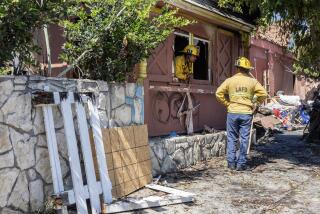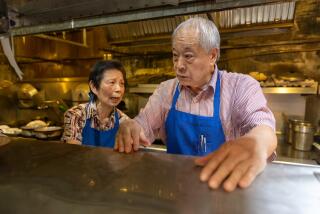Golden Memories? : Downey McDonald’s Stand Goes Back to ’53 but Its Days May Be Numbered
Joyce Lawrence discovered McDonald’s hamburgers under a pair of giant golden arches in Downey.
“It was 1957 and I was at Downey High School when I had my first burger there,” the Downey city councilwoman said. “You could get a hamburger, fries and a Coke and get change back from 50 cents.”
Lawrence still buys Big Macs occasionally at the same stand, which is virtually unchanged almost 40 years after it opened in August, 1953, at Lakewood Boulevard and Florence Avenue.
With its two golden arches, red and white tile walls and towering neon sign crowned by Speedee the Chef, it is the only McDonald’s still operating with the chain’s original architecture.
And its future is in doubt, with Downey officials fearing that the stand may be closed, relocated or modified and lose its historical significance. The lease on the property is up this summer and there have been rumors on and off for years that the stand was in danger.
John Dawson, real estate manager with McDonald’s Los Angeles regional office, would confirm only that the company is considering changing the location or modifying the present stand.
But not trusting to chance, Downey officials are rallying to save it.
“I don’t think people making the final decision on this know how important this McDonald’s is, not just for Downey but for Southern California and clear across the country,” Lawrence said. “It’s ‘50s nostalgia for some people, part of our commercial history, the forerunner of most of our fast-food business.”
The Downey McDonald’s was the third location opened, one of about 1,000 golden-arches stands that were the company prototype until 1968. The outlet that introduced the golden arches--a converted car hop drive-in in San Bernardino--and the second, in Phoenix, have been demolished. While others remain--one is a McDonald’s museum--only the one in Downey is still serving burgers.
Downey officials say the problem is economic. The company-owned stand is losing as much as $50,000 a year, is too small to house up-to-date equipment and lacks a drive-through window, the officials said.
The property was bought in 1982 by The Pep Boys--Manny, Moe & Jack automotive company, which has a store a few doors away. The company and McDonald’s are negotiating on the lease, which expires in August.
Rumors circulated that Pep Boys wanted the land for parking, but a company executive in Philadelphia denied this. “We want a tenant, and they are the most logical tenant if only because of the nostalgic value,” said Pep Boys Vice President Fred Stampone.
Last year, rumor had it that McDonald’s wanted to move the sign to a nearby location and tear down the old stand, selling the distinctive red and white building tiles to raise money for the Ronald McDonald Foundation.
Things seemed shaky, too, when the hamburger stand opened on Aug. 18, 1953, across the street from a citrus grove. One man who remembers is Richard McDonald, 84, who started the business in 1948 in San Bernardino with his late brother, Maurice.
In a telephone interview from his home in Bedford, N. H., McDonald said people thought the Downey stand would flop, “but that night, you couldn’t get within a mile of the place. There were hundreds and hundreds of people.”
McDonald said he devised the golden arches for the Phoenix stand so motorists would see the low building from the road.
“We had a large colonial home with four big columns in San Bernardino,” he said. “I drew in a couple of those, but they looked terrible. Then I drew in one arch running parallel with the building. That looked a little better. Then I drew in two arches like they finally came out.”
The brothers had been running a San Bernardino car hop drive-in since 1940. But after World War II, McDonald said, people’s eating habits changed: “They were impatient and we were starting to get complaints about how slow the service was. We thought there must be a faster system.”
So the car hop drive-in was transformed into a hamburger stand. “We advertised (that) instead of serving you in 20 minutes, we’re going to serve you in 20 seconds,” he said.
Observers say the Downey stand survived because it was owned for more than 35 years by Roger Williams and Burdette Landon, who got their franchise from the McDonald brothers. Even after the company was sold to Ray Kroc in 1961, Williams and Landon maintained their independence, spurning corporate offers to buy their store. Williams and Landon were in their 80s when they finally sold to the company in 1990.
Architectural historian Alan Hess calls the McDonald’s an invaluable piece of American history, a great expression of mid-20th-Century eating habits.
“What they have here is an icon equal to the 1950s Cadillac fin, the picture of Marilyn Monroe over the subway grate, or Elvis Presley on the Ed Sullivan Show,” Hess said. “They have something here that is engraved on the consciousness of everyone born since 1940.”
At McDonald’s on a recent afternoon, customers--from businessmen in ties to high school students just out of class--were lined up for burgers and fries.
Downey receptionist Denise Gonzales said she first visited the stand nearly 20 years ago when she was 5. “I like the little guy up there, the sign,” she said, pointing to Speedee the Chef.
The towering, 60-foot Speedee, added in 1960, runs on legs of neon. He wears a white hat, white coat, blue pants and bow tie, and he’s winking as if to say, “Come on in.”
The main change at the stand over the years has been the menu, which has grown since 1953, when it featured eight items and service calculated in seconds.
The interior was rebuilt after a 1978 fire, but the squat stand is still marked by its distinctive tiles, angled roof and the curving, 25-foot neon-lighted golden arches at each end. An overhang, which originally protected walk-up customers from the elements, shades a group of red tables and stools.
Councilwoman Lawrence recalls that by the 1960s, the stand had become a rowdy spot. “At that time, it was cruised by a lot of kids. Some girls in our senior class put on a skit about how it was evil to go to Mac’s. They dressed like temperance women and carried signs that said, ‘Macs is evil.’ ”
For 15 years, Laguna Beach real estate agent Glen Fishbach has been coming to the McDonald’s when he’s in the area--about 50 times by now. “Let them modernize the food preparation area, but preserve the building and ambience,” he said. “You need a little corniness and garishness, particularly if it’s an original.”
The stand has capitalized on its historic significance, hawking souvenirs and attracting camera-toting tourists. A classic car club and a motor scooter group from England stopped there. In 1984, a girls basketball team from Smith, Nev., drove seven hours through the night to stop at McDonald’s for breakfast before heading to Disneyland.
The Downey Historical Society named McDonald’s a landmark in 1980. Four years later, it was declared eligible for the National Register of Historic Places, but Pep Boys declined to have it included for fear it could hinder use of the property.
Preservationists concede that saving the historic stand will be difficult if McDonald’s decides the arches must fall.
Said Pete Moruzzi, an officer of the Los Angeles Conservancy, which supports preservation of the stand: “Without public support of these types of landmarks, they will be torn down. But if the local community feels strongly, it can have an effect.”
Times community correspondent Suzan Schill contributed to this story.
More to Read
Inside the business of entertainment
The Wide Shot brings you news, analysis and insights on everything from streaming wars to production — and what it all means for the future.
You may occasionally receive promotional content from the Los Angeles Times.










